Imagine you’re catching up with a friend about your latest online shopping adventures, and out of nowhere, you find yourself smitten with a brand you’d never heard of before. Sound familiar? You’re definitely not alone.
In fact, over 80 percent of consumers stumble upon new brands through casual conversations, and most trust these word-of-mouth recommendations more than traditional advertisements. That’s the magic of a genuine referral.
Successful referral programs are simple, clear, and easy to use. They include eye-catching visuals, clear CTAs, and straightforward rules. The best ones even throw in leaderboards and reward exchanges to keep things fun and competitive. But how do you create a referral program that your customers will love and use? Let’s dive into what makes a referral program great.
Check out how impact.com/advocate can help you drive revenue and attract more customers with word-of-mouth marketing.
Why is ecommerce referral marketing a great way to build brand awareness and revenue?
Referral marketing works because people trust recommendations from friends and family more than ads. Around 86 percent of consumers say recommendations and reviews are important in their purchase decisions, while only two percent consider traditional ads important in their purchase decisions.
Customers trust the opinions of people they know––88 percent of people trust recommendations from friends and family.
Plus, with so many product options, consumers want a voice they trust to give them guidance. That’s why nearly nine in ten shoppers say recommendations are important in their buying decisions.
When customers love your products, they’re likely to share them with their network—and with the right incentives, even more so.
Here’s why ecommerce referral programs are a win-win for your brand:
- Amplified reach: Each referral extends your brand’s reach, bringing in new customers who might not have discovered you otherwise.
- Cost-effective growth: It’s much cheaper than running ads or launching big campaigns—your current customers do the heavy lifting.
- Higher conversion rates: Referred customers are more likely to convert because they come with built-in trust.
- Customer loyalty: Offering rewards strengthens the relationship with your existing customers, turning them into repeat buyers.
5 ecommerce stores with well-structured referral programs
Building a referral marketing program can drive impressive results. By incentivizing customers and making it simple for them to recommend your store, you can create loyal brand advocates and drive new business your way.
However, it’s not always easy to know how to structure your referral program for the best results. To help you build a referral program structure that fits your business, here are five stores hitting the mark.
1. Surreal’s “Refer a Friend” program: fun, simple, and rewarding
Surreal, a UK-based brand known for its delicious and healthy cereals with a quirky twist, has crafted a referral program that perfectly mirrors its playful personality. The program is straightforward and mutually beneficial, making it a standout example in the ecommerce space.
Their “Give 15% Off, Earn £10” program is designed to benefit both new and existing customers, creating a compelling reason to share the brand with friends and family.
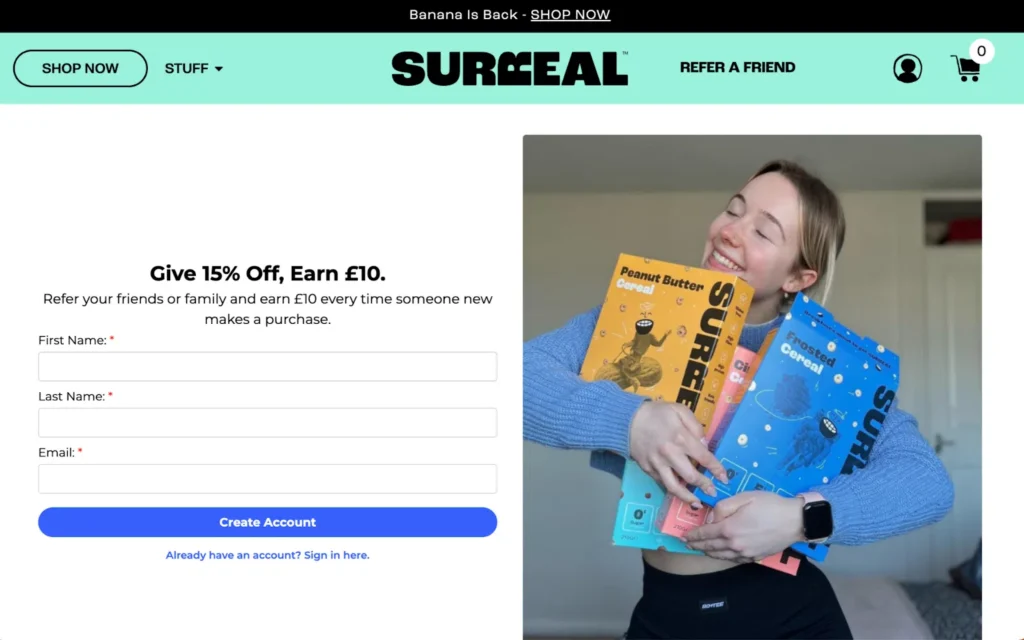
This dual-incentive structure strongly motivates customers to spread the word about Surreal, potentially leading to the organic growth of their customer base.
Surreal’s “Refer a Friend” program is an excellent example of how ecommerce businesses can leverage their brand personality to enhance customer engagement. By combining generous incentives with a fun and easy referral process, Surreal turns satisfied customers into enthusiastic brand advocates. Their approach highlights the effectiveness of aligning referral programs with brand identity to drive growth and build a loyal customer base.
Program highlights
- Playful branding: The referral page is infused with Surreal’s signature humor. Phrases like ‘Stay in the loop for new flavours’, ‘tasty bargains’, and ‘sexy bowl cuts’ add a fun and engaging touch that resonates with customers.
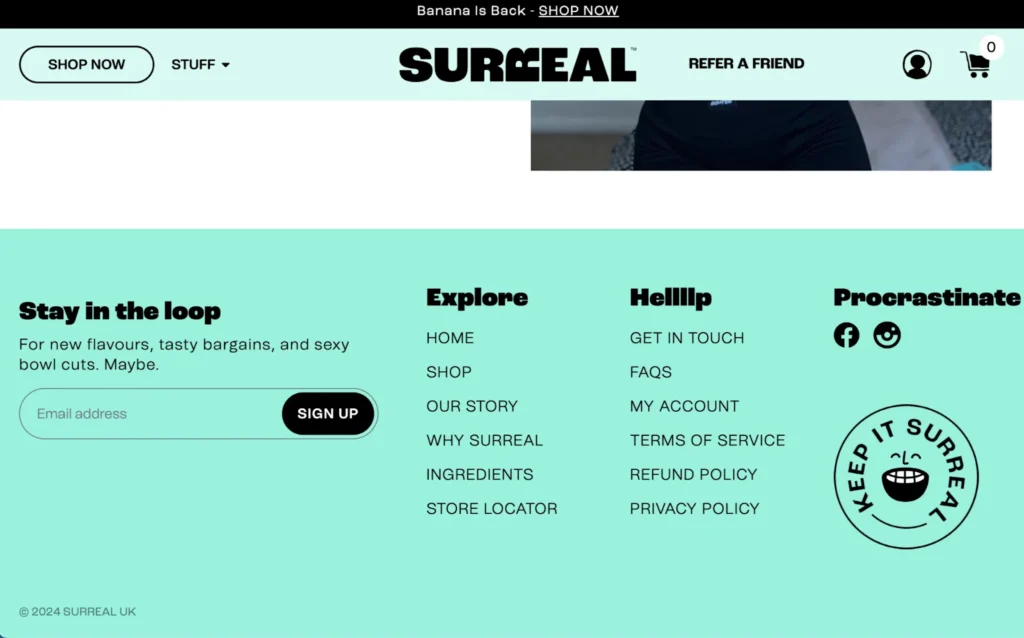
- Easy participation: Getting started is hassle-free. Customers simply provide their email addresses to join the program, lowering barriers to participation.
- Strong community engagement: Surreal invites customers to sign up for their newsletter to receive updates on new flavors and exclusive deals. This keeps the community engaged and excited about what’s coming next.
2. Parks Project’s referral program: straightforward and user-friendly
Parks Project is an apparel and accessories brand inspired by the beauty and spirit of national parks. Their referral program is straightforward and appealing. When you refer a friend, they receive 20 percent off your first purchase, and you get 20 percent off for each successful referral. This mutual benefit provides a strong incentive for customers to share the brand with friends and family, helping to expand their customer base through word-of-mouth.

The program is easy to join—simply enter your email address on their referral page to start referring friends. The simplicity and clarity of the process increase the likelihood that customers will take part.
In addition to the referral program, Parks Project enhances customer engagement by offering a 10 percent discount when you sign up for their newsletter. This provides immediate value and keeps customers informed about new arrivals, exclusive offers, and events.
By combining generous incentives with an effortless referral process, Parks Project effectively motivates customers to become brand ambassadors. Their approach is a great example of how clear rewards and simplicity can drive customer engagement and business growth.
Program highlights
- Attractive discounts: Offering 20% off is a significant saving, making both the referrer and the referee feel valued.
- User-friendly process: The referral system is easy to navigate, encouraging more customers to participate.
- Quality products: With a wide range of products inspired by national parks, customers have plenty of appealing items to choose from.
3. YoloFoods has easy-to-understand language and visuals
YoloFoods uses science-backed research to create healthy gourmet meals. The brand nails simplicity with a referral program that anyone can follow. The language on their referral page is clear, removing any confusion about how to refer friends or earn rewards. On top of that, the brand uses eye-catching visuals that make each step even easier to understand.
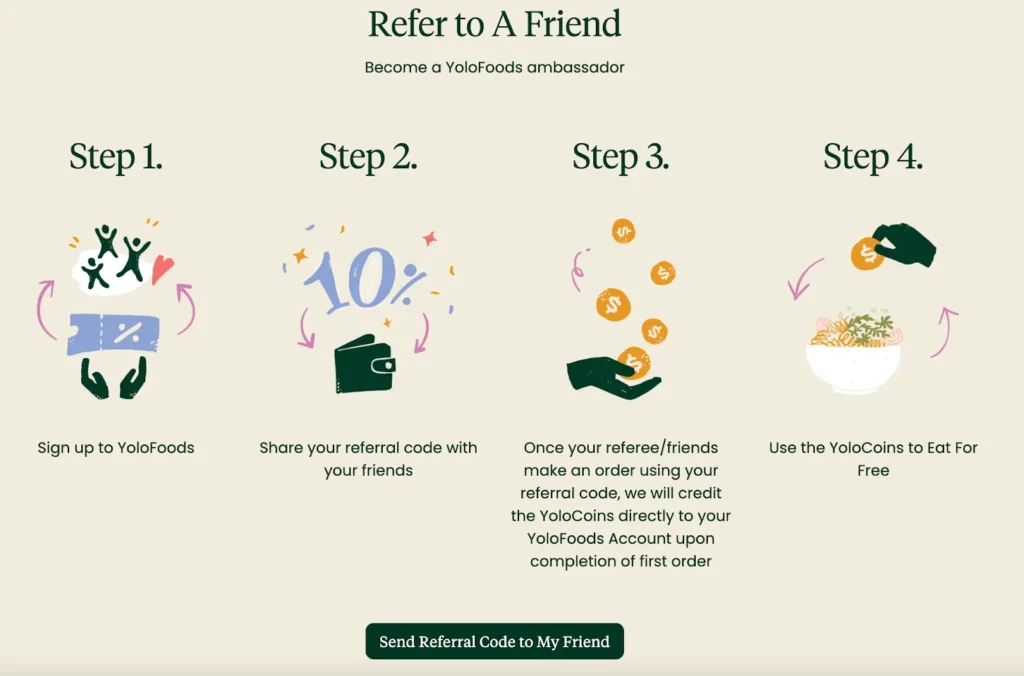
The program offers multiple ways for customers to earn points, which they can redeem for discount vouchers. Customers can earn points by referring friends, following the brand on Instagram, or sharing a post on Facebook. YoloFoods also gives shoppers points for their birthdays. This flexibility motivates customers to participate.
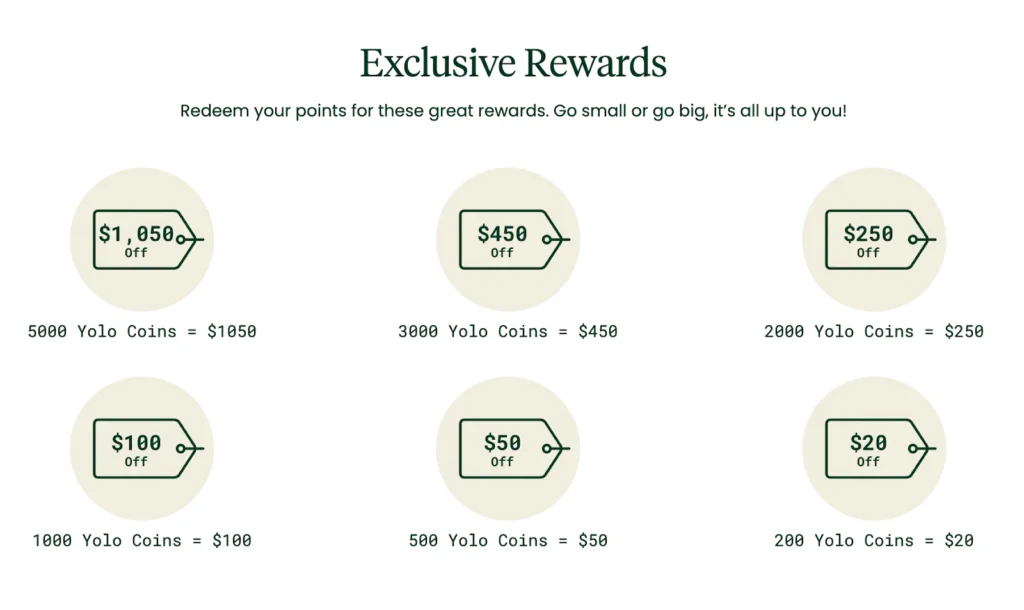
YoloFoods also has a robust affiliate program managed on impact.com. By automating its partner management, YoloFoods expands its reach while simplifying the process for both customers and partners. Plus, the team achieved seven times their affiliate revenue.
Program highlights
- Gamified element: Customers experience the fun of accumulating coins to redeem discounts and vouchers.
- Easy-to-understand language: The simple copy makes it quicker for participants to get started.
- Multiple ways to earn coins. The continuous coin-earning feature meets customers throughout the buyer’s journey, helping Yolofoods stay top-of-mind.
4. Casper offers third-party gift cards—it makes business sense
Mattress and bedding retailer Casper has an effective referral program—it’s simple and offers clear rewards for both the referrer and the person being referred. Instead of offering discounts on future purchases, Casper rewards referrers with Amazon gift cards. This makes perfect sense since most customers won’t need another bed for 10 years. The gift card option is far more practical and attractive, giving referrers a tangible benefit they can use immediately.
The brand uses a double-sided program where both the advocate and referred person are rewarded. This is a proven method for boosting participation. Our research found that 78 percent of brands use double-sided programs, and 65 percent of referrers prefer when both parties benefit. Casper’s approach fits this preference, making the program even more appealing to its customers.
Program highlights
- Double-sided program: The referrer and referred are rewarded, encouraging all-around participation.
- Tailored rewards: The brand offers rewards based on individual customer needs.
- Easy-to-share link: Users can copy the referral link to share on various platforms or email it directly to friends.
5. Good AirX gives new and existing customers a percentage discount to drive purchases
GoodAirX is an ecommerce store that sells a wide range of air purifiers. Its referral program encourages both new and existing customers to make purchases. By offering a percentage discount to both the referrer and the person they refer—but giving a slightly larger discount to the referrer—it motivates customers to actively spread the word. Advocates receive a fair reward while driving sales for the business.
Both parties must purchase to unlock the discount, ensuring the program consistently drives traffic to the store. Plus, the program’s ease of use allows customers to create personalized referral links they can share across any platform, making it easy to spread the word.
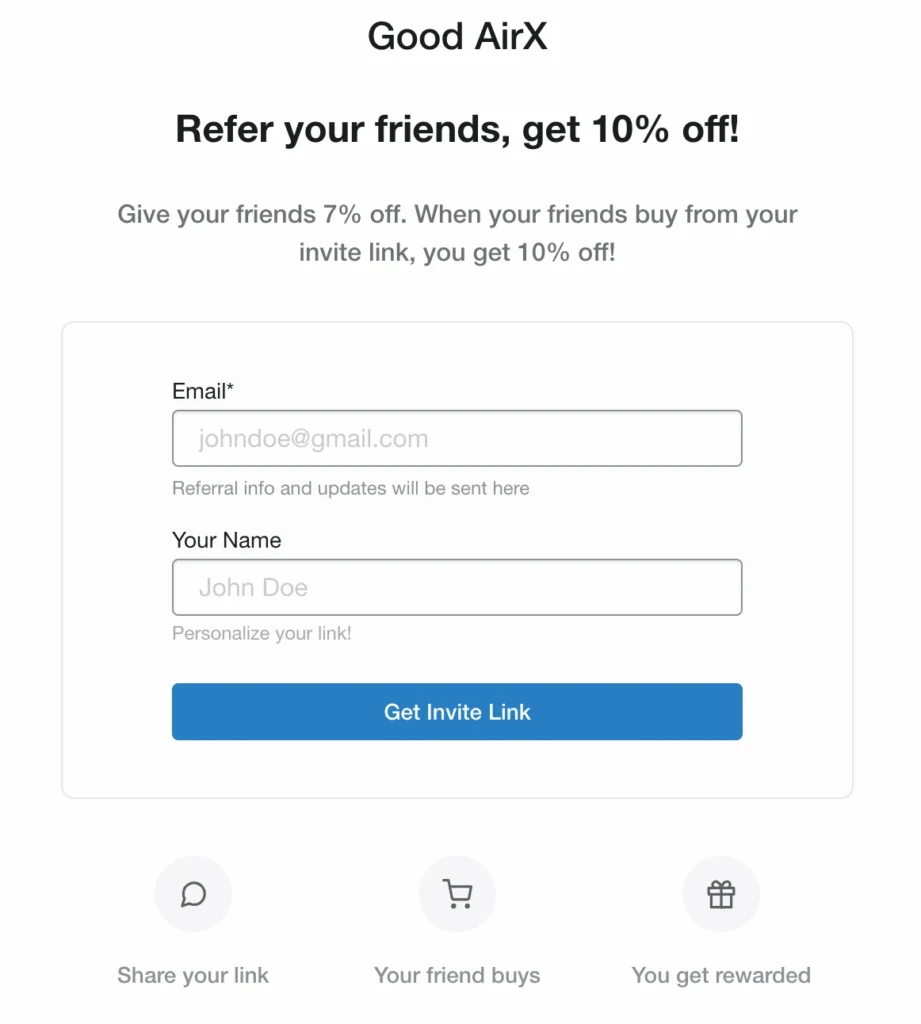
Program highlights
- Double-sided program: Both parties get rewarded with a percentage discount.
- Referrers can create personalized links: Personalization can entice potential customers more than a generic brand email.
- Easy-to-understand program: The program is explained in simple terms, step by step to guide users through the process.
Pitfalls to avoid when creating an ecommerce referral program
Now that you know what makes a referral program successful, let’s look at common mistakes that could get in your way.
Hiding your referral program
One of the biggest mistakes brands make is hiding their referral program where customers can’t easily find it. If your program isn’t front and center, it might as well not exist.
Make sure it’s visible across your website—on product pages, in your email campaigns, and even at checkout. The more places customers see it, the more likely they are to participate and share. A well-promoted referral program gets attention, while a hidden one gets overlooked.
Offering low or irrelevant rewards
If the reward doesn’t excite your customers, they won’t be motivated to refer anyone. Offering low-value or irrelevant rewards is a quick way to derail your referral program. Make the incentives enticing and aligned with what your customers actually want—whether discounts, free products, or exclusive perks. The better the reward, the more likely customers will spread the word and engage with your program.
Displaying widgets that are difficult to find and navigate
If your referral widgets are buried deep in your site or hard to use, customers will lose interest fast. Complex or hidden referral forms create friction, discouraging even your most loyal fans from participating. Make your widgets mobile-friendly, plus easy to find and navigate. The smoother the process, the more likely people are to refer friends and family without getting frustrated.
Not continually adjusting the program to match changing customer needs
Customer preferences change over time, and your referral program needs to keep up. You risk losing engagement if you don’t regularly review and tweak your program. Whether updating the rewards, refreshing the referral messaging, or making the process more user-friendly, staying in tune with your customers’ evolving needs is key to maintaining interest and maximizing results.
Checklist for creating a good ecommerce referral program
What makes a referral program truly successful? Let’s break down the key points from the examples above:
- Keep it simple: A clear, easy-to-understand program encourages more participation. Customers don’t want to navigate complicated rules to refer their friends.
- Use eye-catching visuals: Make sure your referral page grabs attention with bold, engaging visuals that guide customers through the process.
- Offer relevant rewards: High enough rewards that matter to your customers, like cashback or discounts, are essential to motivating them to refer others.
- Clear CTAs: Strong, actionable calls to action ensure customers know exactly what to do next.
- Multiple earning opportunities: Whether through points, cash, or other incentives, offering various ways to earn makes your program flexible.
- Get customer feedback: Regularly asking for feedback ensures that you meet customer expectations and can improve your program over time.
Customer feedback is especially crucial. It allows you to adapt the program to changing preferences and catch any roadblocks that may deter people from participating. Plus, some rewards work better than others.
For instance, research shows that giving a reward tied to the brand (e.g., a percent discount, points, or gift cards) drives more referrals than giving a cash payout. However, sometimes using a third-party reward makes more sense.
Here are some more checklist items to consider:

Make referral programs part of your marketing playbook
Referral programs are a powerful tool for ecommerce brands looking to boost revenue and brand awareness. By tapping into customers’ trust in personal recommendations, you can drive new traffic and encourage repeat purchases.
The examples above show that the most successful referral programs are simple, offer relevant rewards, and continuously evolve based on customer feedback. When executed well, a referral program attracts new customers and fosters loyalty, creating a win-win situation for both your brand and its advocates.
FAQs
Start by choosing a referral platform that integrates with your ecommerce store. Set clear rules for how customers can refer friends and what rewards they’ll receive. Offer attractive rewards, like discounts or cashback, to the referrer and the referred person. Promote the program across your website, email campaigns, and social media. Lastly, track its performance and regularly gather customer feedback to make improvements.
A good referral rate typically falls between 2 and 3 percent. However, some programs, especially in niche markets or with strong incentives, can see rates as high as 5 percent. Tracking your referral rate helps you gauge program success and make improvements.
A successful program is simple, offers valuable rewards, and provides clear instructions. It should have engaging visuals, easy sharing options, and a strong incentive for the referrer and their friend. Regularly collecting customer feedback and making adjustments based on performance also keeps the program effective.
Want to learn more about how referral marketing strategies can grow your business? Check out these resources:
- The state of referral marketing report 2024 [research report]
- Top 6 customer referral marketing trends your brand can leverage in 2024 [blog]
- 7 referral marketing strategies to grow your retail business [+stand-out brand examples] [blog]
- Turn delighted customers into revenue-driving advocates [ebook]
- More than a pop-up: Building a customer referral program that scales [+ the tech that drives it [blog]






